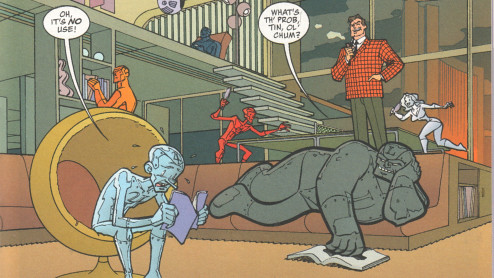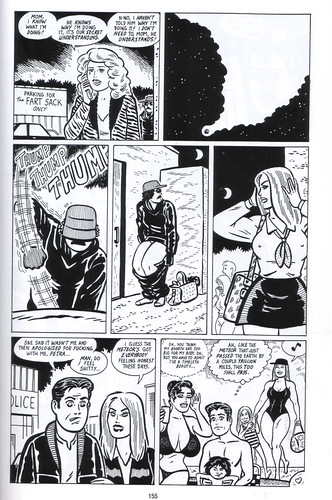The first transition is type 4, from the ex-girlfriend to a meteor in space (that had been a constant metaphor in the story); this transitions to the next sequence of three panels, which have close to action-to-action (type 2) transitions as the new girlfriend (in drag) beats up the ex and changes back to regular clothes; then there's a type 4 transition to an explanatory scene; then a type 4 transition to a denouement scene.
What is interesting to me is than none of these transitions are assisted by captions; there's no "The next day" or "Later..." to help the reader out. There's sometimes visual help - you can see the disguised assailant in the background of the first panel - but overall, Gilbert's style requires a lot of engagement and attention to detail on the part of the reader, who must note clothing changes, background changes, subtleties of dialogue, and other specifics to determine the movement through time and place in the story, and to make sense of the plot. McCloud would say that the reader is required to add a lot of closure.
I'm not sure where I will be going with this analysis; I suppose with both Locas and Palomar at hand I could do a substantial quantitative analysis of panel transitions for each brother, and see if that makes meaning happen. What I thought was more interesting, perhaps, was that I couldn't remember the numbering in McCloud's scheme, so I pulled out my copy of Understanding Comics. While I found the information in a heartbeat, it took me about a half-hour to finally pull myself out of the book: I was re-reading it yet again. Of course, I then dipped into Locas and Luba to look for a sample page or two. There went another half-hour, as I read a story I hadn't yet gotten to. So I guess the upshot is that if I am going to do a formal analysis of this stuff, I had better block out a lot of time.
:::::::::::::::::::::::::::::::::::::::::::::::::::::::::::::::
With all the obscure characters showing up in 52 (not that I'm buying it, mind you, just reading blogs), I just wanted to throw in my nominations for resurrection, The Protectors of Starzl:
Terrane, Ocana, and Etheran originally appeared in Justice League of America #18 (March, 1963); their story was reprinted in Giant JLA #93 in October 1971. After neutralizing the League, these dudes were eventually beaten by Snapper Carr, because their invincibility was based on hyped-up autosuggestion rather than the actual magnitude of their powers. I still always thought they were pretty cool, even if they were androids*.
Here they are calling out the League, and calling for a revival:
Terrane, Ocana, and Etheran originally appeared in Justice League of America #18 (March, 1963); their story was reprinted in Giant JLA #93 in October 1971. After neutralizing the League, these dudes were eventually beaten by Snapper Carr, because their invincibility was based on hyped-up autosuggestion rather than the actual magnitude of their powers. I still always thought they were pretty cool, even if they were androids*.
Here they are calling out the League, and calling for a revival:
*The original story actually included a footnote to the word android and explained that it referred to "an artificial human being, made in a laboratory."






1 comment:
Wow, I forgot all about the Protectors of Starzl.
Yeah, come on DC! Bring them back!!!
Oh, and I always preferred Jaime as well - mostly because I used to have a bit of a crush on Maggie and Hopey.
Lame, I know.
Post a Comment